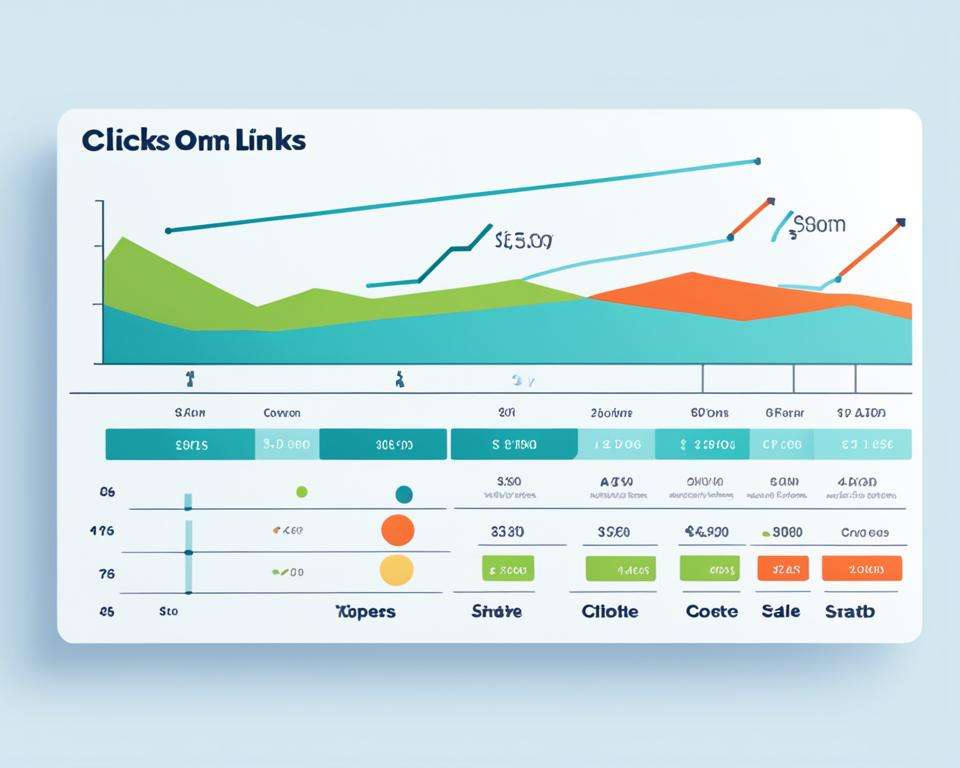Welcome to the world of affiliate marketing. As a marketer, it’s important to understand the metrics that can help you measure the success of your affiliate strategies. By tracking key performance indicators and conducting thorough affiliate program analysis, you gain valuable insights into how your campaigns are performing and identify areas for improvement.
When it comes to affiliate marketing, metrics play a crucial role in evaluating the effectiveness of your campaigns. By monitoring these metrics, you can make data-driven decisions to optimize your affiliate marketing efforts and achieve better results.
In this article, we will explore the essential affiliate marketing metrics that you should track to measure your success. From analyzing your affiliate program to monitoring conversions, optimizing click-through rates, and measuring ROI, we will cover everything you need to know to improve your affiliate marketing campaigns.
Key Takeaways:
- Tracking affiliate marketing metrics helps measure the success of your campaigns.
- Key performance indicators provide insights for improving affiliate strategies.
- Affiliate program analysis helps identify areas for optimization.
- Tracking conversions and optimizing click-through rates enhance campaign performance.
- Measuring ROI and monitoring conversion rates gauge financial success.
Tracking Conversions and Optimizing Click-Through Rates for Affiliate Marketing
In the world of affiliate marketing, tracking conversions and optimizing click-through rates are essential for driving success. By understanding how to measure and analyze these key metrics, you can make data-driven decisions to enhance the performance of your affiliate campaigns. In this section, we will explore the techniques and strategies to ensure accurate conversion tracking and click-through rate optimization for your affiliate marketing efforts. Let’s dive in!
The Importance of Tracking Conversions
Tracking conversions is crucial to evaluate the effectiveness of your affiliate marketing campaigns. It allows you to measure the actions taken by users after clicking on your affiliate links, such as making a purchase, filling out a form, or subscribing to a newsletter. By tracking conversions, you can determine the ROI of your affiliate efforts and identify which campaigns and channels are driving the most valuable actions.
Implementing proper tracking mechanisms is essential for accurate conversion tracking. One effective method is to use conversion tracking pixels or codes provided by the affiliate networks or tracking platforms. These pixels are placed on the thank you or confirmation pages of your website, enabling you to capture the conversion data and attribute it to the appropriate affiliate source.
Optimizing Click-Through Rates for Better Performance
Click-through rate (CTR) is a key metric that measures the percentage of users who click on your affiliate links compared to the total number of impressions or views. A high click-through rate indicates that your affiliate content is engaging and compelling, driving users to take action.
To optimize your click-through rates, consider the following strategies:
- Create compelling and relevant content: Craft attention-grabbing headlines and persuasive copy that clearly communicates the value proposition of the product or service you are promoting.
- Experiment with different call-to-action (CTA) buttons: Test different CTAs to determine what resonates best with your target audience. Examples include “Buy Now,” “Learn More,” or “Sign Up Today.”
- Improve website and landing page design: Ensure your website or landing page is visually appealing, user-friendly, and optimized for conversions. A clean and intuitive design can significantly impact click-through rates.
- Perform A/B testing: Test different variations of your affiliate content, such as different images, headlines, or CTAs, to identify the most effective combinations that drive higher click-through rates.
By continually monitoring and optimizing your click-through rates, you can improve the performance of your affiliate marketing campaigns and increase your chances of generating conversions.
Analyzing the Overall Affiliate Program
While tracking conversions and optimizing click-through rates are crucial for individual campaigns, it’s equally important to analyze the overall performance of your affiliate program. By conducting a comprehensive affiliate program analysis, you can identify strengths, weaknesses, and areas for improvement.
Consider assessing the following key aspects of your affiliate program:
- Affiliate recruitment and retention: Evaluate the effectiveness of your affiliate recruitment strategies and the ongoing support provided to affiliates to ensure their continued engagement.
- Commission structure and incentives: Analyze the commission rates and incentives offered to affiliates to ensure they are aligned with the target market and motivate desired actions.
- Tracking and reporting capabilities: Review the accuracy and comprehensiveness of the tracking and reporting tools used in your affiliate program to ensure affiliates have access to meaningful data.
- Collaboration and communication: Assess the level of collaboration and communication between your brand and affiliates, ensuring effective communication channels are in place for sharing updates, promotional materials, and performance insights.
By analyzing the overall affiliate program, you can identify areas of improvement and implement strategies to maximize the success of your affiliate marketing efforts.

| Month | Impressions | Clicks | CTR | Conversions | Conversion Rate |
|---|---|---|---|---|---|
| January | 50,000 | 2,500 | 5% | 100 | 4% |
| February | 60,000 | 3,200 | 5.3% | 120 | 3.75% |
| March | 70,000 | 3,800 | 5.4% | 150 | 3.95% |
This sample table displays the performance data for three months, highlighting the number of impressions, clicks, click-through rates, conversions, and conversion rates. Analyzing this data can provide valuable insights into the success of your conversion tracking and click-through rate optimization efforts, allowing you to make informed decisions to improve your affiliate marketing campaigns.
Increase Your Affiliate Marketing Success
Tracking conversions and optimizing click-through rates are vital components of a successful affiliate marketing strategy. By understanding the importance of accurate conversion tracking, implementing strategies to optimize click-through rates, and analyzing the overall performance of your affiliate program, you can make data-driven decisions to drive better results.
Next, we will explore the critical aspects of measuring return on investment (ROI) and monitoring conversion rates for affiliate marketing campaigns. Stay tuned for valuable insights and actionable strategies to enhance your affiliate marketing efforts.
Measuring ROI and Monitoring Conversion Rates for Affiliate Marketing Campaigns
In the world of affiliate marketing, understanding the financial success of your campaigns is crucial. Measuring return on investment (ROI) and monitoring conversion rates are key metrics that can provide valuable insights into the performance of your affiliate marketing efforts. By analyzing these metrics, you can optimize your campaigns, increase profitability, and make data-driven decisions.
The Importance of ROI Measurement
ROI measurement allows you to determine the profitability of your affiliate marketing campaigns. By calculating the ratio of the net profit generated from your campaigns to the total investment, you can gauge whether your efforts are yielding positive returns. This metric helps you assess the effectiveness of your strategies, identify high-performing campaigns, and allocate resources wisely.
To measure ROI, use the following formula:
ROI = (Net Profit / Total Investment) x 100
Analyze the data obtained from ROI measurement to identify which campaigns are delivering the best results. This analysis can help you optimize your marketing activities, allocate budgets effectively, and enhance your overall profitability.
Monitoring Conversion Rates
Conversion rate monitoring is another critical aspect of affiliate marketing analytics. The conversion rate represents the percentage of visitors who take the desired action, such as making a purchase or filling out a form. Monitoring and analyzing conversion rates allow you to identify opportunities for improvement and optimize your campaigns for better results.
Start by setting up robust tracking mechanisms to accurately measure and monitor conversion rates. Use affiliate tracking software or other analytics tools to track conversions at every stage of the customer journey. By gathering comprehensive data, you can identify potential bottlenecks, optimize landing pages, and improve the overall user experience to boost conversion rates.
Regularly monitor and analyze the conversion rates for different campaigns, promotional channels, and affiliate partners. Identify patterns, trends, and areas for improvement. By focusing on optimizing conversion rates, you can increase the effectiveness of your affiliate marketing campaigns and maximize your ROI.
Leveraging Affiliate Campaign Analytics
To gain deeper insights into the performance of your affiliate campaigns, it’s essential to leverage affiliate campaign analytics. These analytics provide valuable data on various metrics, including click-through rates, conversion rates, revenue generated, and the performance of individual affiliates.
Utilize the analytics tools provided by your affiliate network or use third-party analytics platforms to gather and analyze campaign data. Look at granular data such as impressions, clicks, and conversions to understand which affiliates are driving the most revenue and which campaigns are yielding the highest ROI.
By leveraging affiliate campaign analytics, you can optimize your strategy, allocate resources effectively, and build strong relationships with high-performing affiliates. Regularly review and adapt your strategies based on the insights gained to continually improve the performance of your affiliate marketing campaigns.
Remember, measuring ROI and monitoring conversion rates are invaluable tools in affiliate marketing. These metrics provide actionable insights that can guide your decision-making process, help you optimize your campaigns, and drive success in this competitive landscape.

Conclusion
Understanding and tracking affiliate marketing metrics is paramount when it comes to measuring the success of your affiliate strategies. By consistently monitoring key performance indicators, conducting comprehensive program analysis, tracking conversions, optimizing click-through rates, measuring ROI, and monitoring conversion rates, you can make informed decisions to enhance your affiliate marketing campaigns.
Regularly reviewing and adapting your strategies based on the insights gained from these metrics is crucial to maximizing your success in affiliate marketing. By leveraging the power of analytics and data-driven approaches, you can identify areas of improvement, optimize your campaigns, and drive better results.
Remember, the Affiliate Marketing industry is constantly evolving, so staying up-to-date with the latest trends and best practices is essential. Continuously experimenting, testing, and refining your strategies can help you stay ahead of the competition and achieve long-term success in this highly competitive landscape.
FAQ
Why are affiliate marketing metrics important?
Affiliate marketing metrics are important because they help you track and measure the success of your affiliate strategies. By analyzing these metrics, you can gain insights into the performance of your affiliate program and identify areas of improvement.
What are key performance indicators (KPIs) in affiliate marketing?
Key performance indicators (KPIs) in affiliate marketing are specific metrics used to measure the success of your affiliate program. These metrics can include click-through rates, conversion rates, average order value, revenue per visitor, and customer lifetime value, among others.
How can I analyze my affiliate program?
To analyze your affiliate program, you can use various methods such as tracking and reviewing affiliate sales data, monitoring KPIs, conducting qualitative surveys or interviews with affiliates, and benchmarking your program against industry standards and best practices.
How can I track conversions in affiliate marketing?
To track conversions in affiliate marketing, you can utilize tracking tools and software that attribute conversions to specific affiliate partners. These tools typically use tracking links or cookies to record and attribute conversions to the appropriate affiliates.
What are the ways to optimize click-through rates in affiliate marketing?
To optimize click-through rates in affiliate marketing, you can focus on improving the visibility and attractiveness of affiliate links, crafting compelling and targeted call-to-actions, optimizing landing pages, testing different creatives and placements, and refining your targeting strategies.
How do I measure return on investment (ROI) in affiliate marketing?
You can measure ROI in affiliate marketing by comparing the revenue generated from your affiliate campaigns to the costs incurred, including affiliate commissions, advertising expenses, and any other associated costs. This allows you to determine the financial effectiveness of your affiliate marketing efforts.
Why is monitoring conversion rates important in affiliate marketing campaigns?
Monitoring conversion rates in affiliate marketing campaigns is important because it provides insights into the effectiveness of your campaigns in terms of driving desired actions, such as purchases or lead generation. By monitoring conversion rates, you can identify underperforming campaigns or opportunities for optimization.
How can I leverage affiliate marketing analytics for campaign performance analysis?
You can leverage affiliate marketing analytics by using tracking tools and software that provide detailed data on affiliate performance, conversion rates, revenue generated, and other key metrics. This data can then be analyzed to identify trends, optimize campaigns, and make data-driven decisions to improve overall campaign performance.
What are some affiliate marketing benchmarks to consider?
Affiliate marketing benchmarks can vary depending on your industry, niche, and campaign objectives. However, some common benchmarks to consider include average click-through rates, conversion rates, revenue per click, average order value, and customer acquisition cost. These benchmarks can help you compare and evaluate the performance of your affiliate campaigns.





